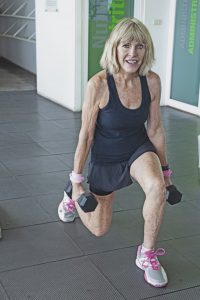 Are there little known secrets of exercise that seniors can use to stay fit despite chronic conditions? I’m trying to get an effective cardio workout through movements that can’t injure the body.
Are there little known secrets of exercise that seniors can use to stay fit despite chronic conditions? I’m trying to get an effective cardio workout through movements that can’t injure the body.
Everybody praises walking because it’s so easy to do, always available, and fairly safe. However, I don’t get my heart rate sufficiently invigorated. Maybe because there aren’t many hills where we live in flat Arizona.
I turn to books by exercise physiologists and experts when I want answers. What I found on Kindle surprised me because it’s been around for several decades.
A Simple Idea Fallen By the Wayside
The book Strength Endurance: Reflections on the Legacy of Dr. Leonard Schwartz is helpful. It summarizes the work of a reformed sedentary psychiatrist who developed exercise involving both upper and lower body movements at the same time. This combined form packs two times the benefits of a single movement, even when using very light weights. For example, one would walk while lifting two pound weights overhead. The aerobic values are doubled, benefiting both heart and muscles.
According to author Chuck Huckaby,
Simply swinging one’s arms with light weights overhead could turn a fairly gentle walk (gentle in that it didn’t pound the knees and joints too badly) into a great cardio workout with the impact of a brisk run.
Dr. Schwartz investigated the exercise research of that time and found that cross country skiers who used their arms and their legs to exercise processed more oxygen and had greater aerobic capacity than any runner. Yet at the time everyone touted the benefits of jogging and running.
Many seniors avoid running because of injury risk. That’s when it occurred to me this combo idea might be an improvement to plain walking. The most aerobic benefit with the lowest level of perceived exertion comes when as much muscle mass is harnessed as possible. The arms and upper body effectively drive the cardio vascular system as much as the legs.
How Seniors Stay Fit
I know many seniors who struggle with avoiding injuries. Sure, they’d love to go out for a brisk run. But is it worth it? It seems to me that exercise physiologists know what benefits the body most. It’s up to us to figure out a way to stay fit given our limitations.
What does this mean for seniors who don’t want to stress to joints and back? Walking while repeatedly raising light weights can multiply the aerobic effect of a slow walk. You are doubling the benefits because you are engaging four limbs instead of two.
This little known secret of exercise isn’t really a secret. It’s just been pushed to the wayside by new machines and fads. But the basics of wisely using movements are still around. It’s up to us to find the professionals who are informed.
I remember two and three years ago when I worked out with Rio, my personal trainer in Mexico. She had me doing walking lunges with light weights. I did squats with upper body movements. In fact, she almost always combined lower body movements with upper body action. (One particularly tricky one: I had to do pushups with alternating clicking my heels together!)
Such simultaneous exercises are particularly beneficial for shorter workouts. (See post on High Intensity Impact Training.)
Combo Exercise for Combo Benefits
There is another fitness element that improves with these combo exercises: balance. Because you are doing different movements simultaneously, it requires some mental concentration and equilibrium. It’s much more challenging than walking and chewing gum at the same time.
Straight walking with weights is simple, but when you get to lunges and other combo exercises, it can be more challenging. Of course, you have to start small because it’s not easy. It’s surprising how little weight you need at first.
Like all exercise, the benefits come with incrementally increasing the intensity. This is where many seniors fail, because they assume they can do what they used to do at a younger age. Start small, start light and slowly improve. Avoid injuries. Stay in the game for the long term.
The Secret Exercise Challenge: Walk With Weights
But you know that, don’t you! Why not try taking some one or two pound weights with you on your next walk? If you have shoulder issues it may not be wise to raise them overhead. Do what you can. I can’t always keep up the pace when I get shoulder level with weights, but I’m slowly getting better. In any case, it’s making my walks more interesting. And effective.
Recommended Reading: Strength Endurance: Reflections on the Legacy of Dr. Leonard Schwartz – creator of “Heavy Hands”, “Panaerobics”, “Longstrength” and “IsoTonOMetrics” By Chuck Huckaby

Recent Comments